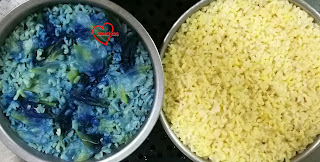I was determined to try working with bean paste dough so I bought the recipe from her and she guided me along by answering my many questions and providing useful sugar paste flower modelling video tutorials that I could refer to. I am not able to share the recipe in this post as Helen has taken time and resources to develop the recipe that is not easily available on the internet at the moment. But I can share my learning journey in this post 😊.
I was curious to know how the bean paste flowers would turn out if I used natural sources of food colouring. Here is my very first attempt at bean paste roses and leaves!
I have to admit that the bouquet isn't entirely made using natural food colouring. The leaves are coloured using gel food colouring. The pink flower has a little pink gel added. I experimented with a few food sources as the dough base and for colouring: white beans, mung beans, purple sweet potato, blue pea flower and freeze-dried raspberry powder.
Making the dough may be a fairly lengthy process. The preparation method of the bean paste is very much like making mung bean paste for mooncake filling. I steamed the soaked mung beans. I did both with and without blue pea flowers.
Before steaming
After steaming. See how the beans absorb the blue colour after steaming!
I also prepared blue pea flower coloured and plain white bean paste.
Freshly made bean paste. I used the same treatment using steamed purple sweet potato to make the paste out of it too. I should have cooked the purple sweet potato paste longer as it was wetter than the bean based ones but it was 12am and I needed my zzzzs 😆.
Bean paste dough before steaming. I created one colour of dough using half blue pea flower coloured mung bean paste and half purple sweet potato paste (top left corner) so there are six portions instead of five.
Freshly made bean paste dough that has been steamed, kneaded and wrapped tightly
Helen provided a few video tutorial resources I could refer to since I am learning how to model roses without any hands-on expert guidance. You may refer to this video on how to shape the roses, this video on how to colour the sugar roses, and this video on how to make the rose leaves. I watched the earlier videos in the series by chef Nicholas Lodge as well to have an alternative view of how to shape the roses. Like me, you may not have the necessary shaping tools. Not to worry. You can use your fingers to shape and pinch where necessary. Won't be as professional looking but still nice enough. The videos mention the use of gauge wires to work with the flowers. I used wooden skewers and a styrofoam board instead. The glue I used is also simply made out of some of the dough dissolved in water instead of edible glue sold in baking supply stores.
An assembled rose made with some purple sweet potato dough so there are tiny specks of the potato on some petals. Mounted on wooden skewer to dry a little.
I managed to get a leaf veiner and I already have a fondant rose leaf cutter at home so I could make the leaves.
Veining the leaf with the leaf veiner
The roses would look even more realistic if I had a petal veiner but I didn't get one.
I absolutely love how the natural colours turn out!
Anticlockwise from the top left: plain mung bean dough, plain white bean dough, half purple sweet potato half blue pea flower mung bean dough, blue pea flower mung bean dough
I tried colouring some white bean paste naturally with freeze-dried raspberry powder but it turned rather dull so I added a little bit of pink gel colouring. The resulting colour is a sweet dusty pink colour!
Check out how soft and flexible the rose petals are when freshly made!
I dusted the flowers only with a little petal dust as I felt they look rather nice on their own without dusting.
My parents were around when I made these roses so they got to try. They love the taste of it! Mum chose the colours of roses that she would like on top of the cake I will be making for her later this month too.
There could be some concern about the short shelf life of these flowers based on the information that's out there on the internet. But with proper drying and storage, these flowers didn't turn mouldy even after a week in the fridge or out in the open (with adequate ventilation) in Singapore! Helen said just don't store them airtight at room temperature where they will turn mouldy fast.
Blessed Mother's Day to all mums out there!
With love,
Phay Shing










hi Phay Shing these are absolutely gorgeous....wat a work of art... i would love to try how it taste like ��. hopefully one day u will be able to share the recipe. love your blog! Elaine
ReplyDeleteHi Elaine,
DeleteThank you 😘. I am unable to share the recipe as my friend Helen has taken time and effort to develop the recipe that I bought from her. If you would like to know, you can contact her via Instagram to purchase the recipe too.
Is the bean paste dough that you mentioned above to be steamed again just coloured mung bean paste? Is the texture like that of sugar paste that we can rolled and thinned instead of piping like buttercream?
ReplyDeleteHi Helen, yes you use it like sugar paste. Just steam again if it has become hardened after storage in fridge or freezer
Delete